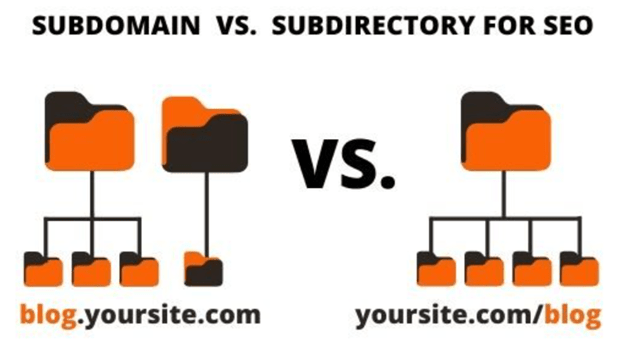SEO Subdomain Vs Subdirectory?

Hand off the toughest tasks in SEO, PPC, and content without compromising quality
Explore ServicesA hotly contested discussion amongst search engine optimization (SEO) professionals is the subdomain vs. subdirectory debate.
Is subdomain or subdirectory better for organic rankings? What is a subdomain, and how do they differ from subdirectories? Does this impact SEO?
Different SEO strategists and online marketers seem to have different views, experiences and opinions on this, and in this article, we want to bring some clarity to this discussion.
We’ll look at:
- What subdomains and subdirectories are
- What Google’s algorithm thinks of subdomains and subdirectories
- The differences and similarities between subdomains and subdirectories
- Which one is best for your website’s SEO
SEO Subdomain Vs Subdirectory
Essentially, a subdomain is a separate website from your main domain, whereas a subdirectory is a collection of files found under your primary domain.


To better understand the difference between a subdomain and a subdirectory, let’s look at each individually.
What is a subdomain?
A subdomain is related to, but not the same, as the main domain. As far as search engines are concerned, a subdomain is a separate domain entirely – it and your main website are different websites.
The URL structure of a subdomain looks like this:
blog.yoursite.com
, where the subdomain comes before the root domain name.
Webmasters might use subdomains to host a separate aspect of their website, use cases such as:
- A blog
- An eCommerce store
- The same website but with a different language
- Separate forms of the same site i.e. optimized for mobiles
- Chat forums
Using subdomains to organize your entire site structure in this manner can be beneficial, mainly if the subdomain represents a different division of your business or targets another country.
The problem with a subdomain is that Google treats subdomains as a separate entity to your domain. Thus, any backlinks or link authority you have grown on your root domain don’t transfer over to your subdomain, and vice versa.
Large companies or websites looking for enterprise-level SEO will benefit from using subdomains to arrange their various locations and services, however for small personal blogs and shops, using a subdirectory is far better for your SEO efforts.
What is a subdirectory?
A subdirectory is a set of web pages or files that are stored within your root URL and are a single domain.
The URL of a subdirectory looks like this:
yoursite.com/blog
, where the subdirectory comes after the root domain.
It might be easier to think of a subdirectory as a subfolder, where your main site is the filing cabinet and your subdirectory is a folder within the cabinet.
From a technical SEO standpoint – that of the structure of your site combined with domain authority – using subdirectories is often the best approach for websites that offer related services in a single language.
Having a single domain to which you want to win backlinks and increase domain authority makes it much easier and much cheaper to do – as domain authority is one of the primary ranking factors in SERPs.
Having a single domain on which to focus your digital marketing and SEO strategy efforts give you better results faster – unless of course, you are an enterprise-level domain with hundreds of thousands of dollars in your marketing budget. In which case, building more than two domains shouldn’t be too much of an issue.
Seo Subdomain Vs Subdirectory: What Are The Differences?
As we’ve said, a subdomain and a subdirectory differ in where files are hosted and how Google search and other search engines perceive the domains.
On a subdomain, your files and information are stored separately from your root domain. On a subdirectory, they are stored in the same place under your top-level domain (tld).
The two are the same in that they will contain the URL of your top-level domain, example.com, but this will come after the subdomain, or before the subdirectory.
Subdomain and subdirectory FAQ
Is subdomain better for SEO?
Determining whether subdomain or subdirectory is best for SEO efforts often depends on the website.
If the website consists of hundreds, if not thousands of different web pages, offering different services and products to different countries, thereby needing different languages on the site, then using subdomains to organize your website can facilitate a better user experience and also structure your sites better in the eyes of search engines.
However, for personal or smaller websites, such as blogs, local businesses, affiliate marketing sites or eCommerce stores, subdirectories are a better choice for hosting because of the shared link equity between top-level domains and their web pages. If you get a certain number of backlinks point to your top-level domain, then all the web pages in your subdirectories benefit from that backlink and grow in domain authority.
Is subdomain bad for SEO?
By no means are subdomains bad for SEO – they are simply different websites that require their own content strategy and backlink building, separate from that of the top-level domain. This means that webmasters need to grow two domains instead of one.
If the webmaster has the resources available – mainly time and money – then there is nothing bad for SEO about having a subdomain.
Can subdomains rank in Google?
Yes, subdomains can most certainly rank in Google. The thing is, they require their own set of backlinks to build domain authority separately from the top-level domain, which takes more time and money on behalf of the webmaster or domain administrator.

For example, this forum subdomain of the website Bandmix ranks on the first page of Google for several keywords, because it has a solid domain authority and backlink profile. You just need to remember that subdomains require their own set of backlinks and content with which to rank in Google, unlike subdirectories that rely on those of the top-level domain.
Summary
Hopefully, this article has given you a better understanding of subdomains and subdirectories and their roles in SEO for your website.
As we’ve mentioned, there is nothing negative about creating a subdomain – it doesn’t hurt your domain’s SEO or anything like that. But creating a subdomain means you will need to double your content marketing and backlink building efforts if you want to promote your subdomain as well as your top-level domain.
If you have your entire website under the same root domain, structured with subdirectories, then it can be much easier to grow the domain authority of your website, and achieve higher ranks in SERPs faster than if you were diluting your digital marketing efforts between two sites.
Which approach is best for you? That depends on the size and scope of your website.
Hand off the toughest tasks in SEO, PPC, and content without compromising quality
Explore ServicesWritten by Adam Steele on July 2, 2021
COO and Product Director at Loganix. Recovering SEO, now focused on the understanding how Loganix can make the work-lives of SEO and agency folks more enjoyable, and profitable. Writing from beautiful Vancouver, British Columbia.





